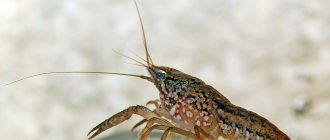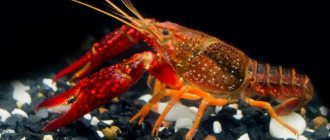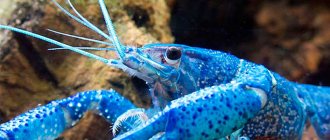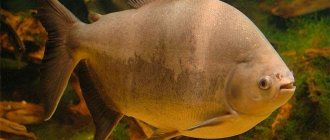The marbled crayfish is an interesting representative of aquarium crustaceans. He is unpretentious in care and food, and the behavior of such a pet is always interesting to watch. The cancer got its name due to its bright color, which strongly resembles marble patterns. In the wild, marbled crayfish live in freshwater rivers. More details about keeping Marbled crayfish in an aquarium will be discussed in this article.
Marble crayfish
General information
The marbled crayfish (Procarambus virginalis) is a freshwater crustacean from the Decapod family. Now it can be found in almost every corner of the planet; it has successfully acclimatized in many regions.
Scientists consider the ancestor of the marbled crayfish to be the crayfish Procambarus fallax, common in the southeastern United States. At one time, they became famous aquarium pets because they are interesting exotic animals, and their care is minimal.
The crayfish reproduced well, and then one day in Germany, thousands of kilometers from their historical homeland, individuals with a very beautiful “marble” color were born, which instantly made them even more popular. But the main surprise was ahead: it turned out that these crayfish acquired the ability for parthenogenesis - the development of an embryo without fertilization. That is, all individuals of marbled crayfish are females who are capable of producing offspring that appear through the normal division of an unfertilized cell. In fact, all offspring are clones of the mother. This is the first time such a phenomenon has been observed in decapod crayfish. At first, the new form of crayfish was attributed to the original species - Procambarus fallax, but in 2015 the taxonomy of the marbled crayfish was revised, and it became an independent species - Procarambus virginalis.
Marbled crayfish is able to reproduce without fertilization. This process is called parthenogenesis
Thanks to its wide distribution in the aquarium hobby and regular introductions from domestic conditions into the wild, this species began its “victorious” march across the planet. At first these were European countries, and later it was discovered in Asia and Africa.
Thanks to its amazing adaptability, the marbled crayfish has become an environmental problem in some countries, as it successfully competes with local species and displaces them from their usual habitats. To reproduce, it needs only one individual, unlike other relatives, so it can quickly capture new territories.
For this reason, the import and sale of marbled crayfish is prohibited in many countries.
Appearance
The marbled crayfish has a body structure typical of decapod crustaceans. The massive cephalothorax is covered with a dense shell - the carapace. Walking legs are attached to this section, the first pair of which bears claws. The jaws and sensory organs (eyes and antennae) are also located here. The abdomen is movable, consists of several segments, under which swimming legs - pleopods - are located. At the end of the abdomen there is a wide caudal fin.
One of the main values of this species is body coloring. The overall color varies from greenish to brown, and the specific pattern resembles the streaks on marble, which is how the crayfish got its name. In young individuals, this color is poorly expressed, but with age it becomes brighter and more contrasting.
The maximum body size is 15 cm. However, it greatly depends on the conditions of detention, so if you place the crayfish in a cramped aquarium, it will not be able to reach this size.
Life expectancy in an aquarium is 2-3 years.
general information
Marbled or, as they are also called, Gray-spotted crayfish are representatives of decapod crayfish. They are freshwater inhabitants. The name, oddly enough, is related to their appearance. Depending on external factors, the surface of the body of crustaceans can have different colors: from black to green or even brown. The shell is decorated with a beautiful pattern reminiscent of a marble surface. And if from an early age the coloring is rather weakly expressed, then over time the contours become clearer and the cancer gets a truly marbled color.
Gray-spotted crayfish are representatives of decapod crayfish
Outwardly, it is difficult to distinguish Marbled crayfish from ordinary crustaceans living in rivers. Still the same cephalothorax , pairs of legs and, of course, claws. On average, crayfish grow up to 12 cm in length, but sometimes they can reach 15 cm. Newborn crustaceans are difficult to notice due to their small size, but they develop quite quickly and increase in size molt
Outwardly, it is difficult to distinguish marbled crayfish from ordinary crustaceans living in rivers
Note! In addition to the usual Marbled crayfish, there are also Cuban crayfish, which are distinguished by their bright blue body color.
Care and maintenance
An adult marbled crayfish can grow up to 15 cm, so to keep one individual you will need an aquarium of at least 40 liters. But it is better to purchase a large container, since crayfish produce quite a lot of waste, and maintaining biological balance in a small volume will be difficult.
The bottom area is more important than the height of the aquarium.
Coarse quartz sand or small pebbles are usually used as soil; this makes cleaning easier, since food residues and waste do not sink deep. It is very important to install a large number of various shelters. They will help to zone the territory if several crayfish live in the aquarium, on the one hand, and will become an excellent refuge during the molting period, when the crayfish is most vulnerable, on the other. For this purpose, you can use artificial caves, plastic tubes of suitable diameter, broken pots, halves of coconuts.
Marbled crayfish love to hide in shelters
The aquarium should be equipped with a powerful filter that will help maintain cleanliness and high quality water. The current can be moderate or strong. If possible, use an internal filter, as marbled crayfish are famous for their ability to escape through the hoses of external filters. 24-hour aeration of the aquarium is very important, especially in the warm season, when oxygen is poorly soluble in warm water.
Once a week it is necessary to change 20% of the water in the aquarium. Most often, tap water is used for this purpose, but it is worth remembering that it may be unsafe for crayfish, for example, it contains chlorine and heavy metals (copper is especially dangerous). To quickly make tap water safe for crustaceans, use Tetra Crusta AquaSafe conditioner. Along with water changes, perform a mandatory soil siphon to remove waste and uneaten food residues. The water should not be very soft, otherwise there will be problems with the formation of the shell.
Optimal water parameters for keeping: T=18-28°C, pH=6.5-7.8, GH=8-12.
Unfortunately, marbled crayfish are not compatible with living plants. They simply use most of the plants for food. Only species floating on the surface of the water are suitable (hornwort, riccia, pistia), as well as Java moss, which often withstands the onslaught of cancer.
Crustaceans are characterized by the phenomenon of molting. It consists of shedding the old hard cover, which does not allow it to grow. A new one forms under it, which remains soft for some time. This is the most difficult and dangerous period in the life of cancer. After all, until the new “clothes” harden, it becomes easy prey even for small species of fish or its relatives. Therefore, after shedding their chitinous shell, crayfish hide in shelters until the new one gets stronger. If you find an old shell of crayfish in the aquarium, do not rush to throw it away. A little later, the pet will eat it to get the necessary minerals for growth and the formation of a new shell. Young crayfish molt more often, as they are growing rapidly.
Relations with neighbors
Large and predatory fish may consider crayfish an addition to their diet and eat them. Cichlids are especially dangerous. Also, you should not keep crayfish and catfish in the same reservoir, since the latter can become food for arthropods. It is not advisable to breed fish with veil-like fins, since the crayfish will too often be tempted to catch and tear off the fins.
If cancer is dangerous for some fish, then others themselves can seriously injure or even kill a molted crayfish with a fragile shell. However, many people manage to successfully keep crayfish and fish in the same aquarium.
You can keep swordtails or guppies in the same aquarium with arthropods. But you should be prepared for the fact that small fish may eventually become food for the animal. All fish that live in an aquarium must swim quickly so as not to get into arthropod’s dinner.
Cancer will do the same to snails.
Neighborhood with fast, active fish that do not show aggression is allowed.
Compatibility
Marbled crayfish can be kept with some types of fish, but it should be remembered that it has a hunter's instinct, and it can try to hunt the smallest individuals. Fast breeding fish such as mollies, platies, swimming in the upper layers of the aquarium, such as zebrafish, and active species such as barbs are good choices.
But cancer will not be able to make friends with bottom-dwelling fish (Corydoras, Ancistrus, Thorakatum). It is better to exclude them from the list of possible roommates. Slow fish and those with veil fins also come here - the crayfish will mercilessly pluck them with its claws. The marbled crayfish is unfriendly to snails and shrimp.
Sometimes the marbled crayfish preys on small fish
You should not combine marbled crayfish with large fish - acars, red parrots, astronotuses, Flower Horns, because crayfish can become easy prey for them, especially after molting.
As for keeping them together with their relatives, this is possible if the volume of the aquarium is sufficient and the crayfish are provided with a large number of shelters. In such a situation, conflicts will be minimal. If this is not ensured, then you need to prepare for constant fights and loss of limbs, which, at the same time, will be restored after a few molts.
Shedding
All crayfish molt periodically. Before molting, the marbled crayfish does not eat anything for a day or two and hides.
If you suddenly see a shell in the aquarium, do not throw it away and do not be alarmed! Cancer will eat it, it contains a lot of calcium it needs.
After molting, the crayfish is very vulnerable and you need to have a lot of hiding places in the aquarium where it can sit out.
Feeding the marbled crayfish
Feeding the marbled crayfish is not at all difficult. It is an omnivorous organism, capable of eating everything its claws can reach: aquatic plants and pieces of vegetables, live and frozen food, dead fish, dried leaves, pieces of fish and shrimp. But we must not forget that any natural food will be unbalanced and can quickly deteriorate the quality of water.
Therefore, it is better to opt for specialized dry food for crustaceans Tetra Crusta. They are developed taking into account the nutritional needs of crustaceans and contain a full range of nutrients and vitamins for healthy growth and longevity. An important advantage of such feed is that it sinks to the bottom and retains its shape for a long time without polluting the water.
Marbled crayfish and universal tablets for bottom inhabitants, for example, Tetra WaferMix or Tetra Pleco SpirulinaWafers, eat well.
Reproduction and breeding
It is very important to understand that even one purchased specimen of marbled crayfish can produce numerous offspring at home. The development of embryos occurs in this species without any fertilization; all individuals are exclusively females.
Puberty occurs at about six months of age. At one time, the female can bring from 20 to 300 eggs. To save most of the offspring, the female should be placed in a separate spawning aquarium, because neighbors can easily feast on the young. Females carry eggs on their swimming legs (pleopods). Their constant movement provides ventilation and a flow of fresh water to the eggs. Incubation of eggs lasts about a month; the cancer spends almost all of this time in the shelter.
Marble crayfish with caviar
Afterwards, smaller copies of the parents are born that are capable of feeding themselves. The mother should be removed when the young crustaceans reach the age of about a month. Juveniles grow unevenly and require periodic sorting to avoid cannibalism.
However, the high survival rate of young crayfish leads to another problem - where to place the numerous offspring? Therefore, you should think about this issue in advance.











